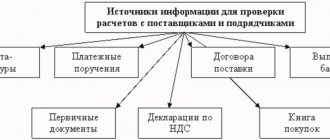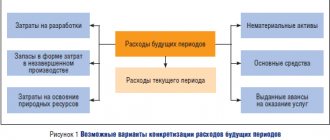Postings for compensation of damages
In practice, there are situations when a company has to compensate for damage caused to another organization.
Read about in what cases this happens and how such expenses are reflected in the accounting and tax accounting of an organization.
In accordance with paragraphs. 13 clause 1 art. 265 of the Tax Code of the Russian Federation, non-operating expenses include expenses in the form of fines, penalties or other sanctions recognized by the debtor or payable by the debtor on the basis of a court decision that has entered into legal force, as well as expenses for compensation for damage caused.
What is meant by compensation for damage caused for the purpose of calculating income tax, Ch. 25 of the Tax Code of the Russian Federation does not explain. There is no specific list of such expenses in this chapter.
Guided by the provisions of paragraph 1 of Art. 11 of the Tax Code of the Russian Federation, let us turn to the norms of civil legislation.
According to Art. 15 of the Civil Code of the Russian Federation, a person whose rights have been violated may demand full compensation for the losses caused to him.
Losses consist of actual damage and lost profits.
Real damage refers to the expenses that a person whose right has been violated has made or will have to make to restore the violated right, as well as loss or damage to his property.
Lost profits are lost income that this person would have received under normal conditions of civil transactions if his right had not been violated.
It seems to us that, without any doubt, an organization can take into account for profit tax purposes only the amount of actual damage.
By law, the culprit organization is obliged to compensate the victim for damages in monetary form. However, the parties may agree on another method of compensation.
For example , the culprit acquires new property to replace lost property or repairs damaged property.
All cases of damage can be divided into two groups:
- due to non-fulfillment or improper fulfillment of obligations under the contract;
- when causing harm to a third party (third party) not related to the organization by contractual relations.
Let's take a closer look at each group.
Improper performance of obligations
In practice, there are often cases when an organization bound by contractual relations with a counterparty violates its obligations under the contract, as a result of which the counterparty incurs losses.
According to paragraph 1 of Art. 393 of the Civil Code of the Russian Federation, the debtor is obliged to compensate the creditor for losses caused by non-fulfillment or improper fulfillment of the obligation. Losses are determined according to the rules of Art. 15 of the Civil Code of the Russian Federation (clause 2 of Article 393 of the Civil Code of the Russian Federation).
If the contract provides for a penalty (fines and penalties) for non-fulfillment or improper fulfillment of an obligation, then losses are compensated to the extent not covered by the penalty (clause 1 of Article 394 of the Civil Code of the Russian Federation).
Consider the following situation.
Example 1 . Let’s say that on March 1, 2007, organization A transferred goods worth 500,000 rubles for storage to organization B. for a period of six months. September 1, 2007
organization B is obliged to return the goods to organization A safely. However, organization B was unable to do this.
As a result of this organization’s failure to comply with storage rules, some goods worth RUB 100,000. turned out to be spoiled.
The agreement does not provide for sanctions for violation by the custodian of its obligations under the agreement.
Organization A does not make claims for compensation for lost profits; it is enough for it that organization B compensates it for actual damage in an amount equal to the cost of the damaged goods.
Organization B agreed to the demands presented to it. Cash compensation in the amount of 100,000 rubles. transferred to the current account of organization A on September 17, 2007.
Legal relations when concluding a storage agreement are regulated by Chapter. 47 Civil Code of the Russian Federation. In this case, organization A is the bailor, and organization B is the custodian (Article 886 of the Civil Code of the Russian Federation).
The custodian is obliged to compensate the bailor for losses caused by loss, shortage or damage to stored items. Losses are defined as actual damage and lost profits (Clause 1, Article 902, Article 393, 15 of the Civil Code of the Russian Federation).
If, as a result of damage for which the custodian is responsible, the quality of the thing has changed so much that it cannot be used for its original purpose, the bailor has the right to refuse it and demand from the custodian compensation for the cost of this thing, as well as other losses (clause 3 of Article 902 Civil Code of the Russian Federation).
The amount of actual damage is determined by agreement of the parties.
In the event of a dispute between the parties regarding the amount of damage, the prices that existed in the place where the obligation was to be fulfilled on the day the debtor voluntarily satisfied the creditor’s claim may be taken into account, and if the demand was not voluntarily satisfied, on the day the claim was filed (p 3, Article 393 of the Civil Code of the Russian Federation).
In the situation under consideration, the amount of actual damage compensated to organization A is equal to the cost of the damaged goods, i.e. 100,000 rub.
In accounting, this amount is taken into account as part of other expenses (clause 11 of PBU 10/99).
In this case, the accountant makes the following entries:
Debit 91/2 – Credit 76
- 100,000 rub. — the amount of damage caused is reflected in the custodian’s other expenses;
Debit 76 – Credit 51
- 100,000 rub. - the amount of damage is transferred to the bailor.
In tax accounting, expenses for compensation for damage caused are taken into account as part of non-operating expenses (clause 13, clause 1, article 265 of the Tax Code of the Russian Federation).
The amount of damage is recognized as expenses either on the date of recognition by the debtor, or on the date of entry into force of the court decision (clause 8, clause 7, article 272 of the Tax Code of the Russian Federation).
Consequently, in September 2007, organization B can attribute the amount of 100,000 rubles to expenses accepted for tax purposes.
Causing harm to a third party (third party)
In accordance with paragraph 1 of Art. 1064 of the Civil Code of the Russian Federation, damage caused to the property of a legal entity is subject to compensation in full by the person who caused this damage.
At the same time, paragraph 1 of Art. 1079 of the Civil Code of the Russian Federation provides that legal entities and citizens whose activities are associated with an increased danger to others (for example, the use of vehicles, mechanisms, etc.) are obliged to compensate for damage caused by a source of increased danger, unless they prove that the damage occurred due to force majeure or the intent of the victim.
The culprit according to Art. 1082 of the Civil Code of the Russian Federation is obliged to compensate for damage in kind (provide an item of the same kind and quality, correct a damaged item, etc.) or compensate for losses caused in accordance with Art.
The guilty employee is ready to voluntarily compensate for the damage
15 Civil Code of the Russian Federation.
Let's look at a specific example.
Example 2 . The organization, while performing construction work, caused damage to the property of a third party. A construction crane fell on a nearby non-residential building in which the company office is located (next to the construction site). Since the work was carried out on a weekend when no one was in the office, no one was injured.
At the same time, the office building itself suffered significant damage. According to the court's decision, the culprit organization must compensate the company for damage by performing work to eliminate the building's deficiencies.
However, a specific list and cost of repair work are not indicated in the court decision.
To determine the amount of damage, the culprit organization invited an expert, whose service cost it 5,900 rubles. (including VAT 18% - 900 rubles.
) To carry out finishing work inside the building, the culprit had to turn to another company, since the guilty party could not carry out this work on its own - this is not its profile. The cost of finishing work performed by the contractor amounted to 118,000 rubles.
(including VAT 18% - 18,000 rubles). The cost of repair work carried out by the culprit organization itself amounted to 600,000 rubles.
In the accounting records of the culprit organization, these transactions are reflected as follows:
Debit 60 – Credit 51
- 5900 rub. — paid for the services of an expert to assess the amount of damage;
Debit 19 – Credit 60
- 900 rub. — VAT is reflected on the cost of expert services;
Debit 91/2 – Credit 60
- 5,000 rub. — the cost of expert services is reflected as part of other expenses (based on the examination report);
Debit 91/2 – Credit 19
- 900 rub. — VAT on the cost of expert services is reflected as part of other expenses;
Debit 60 – Credit 51
- 118,000 rub. — the cost of the work performed by the contractor has been paid;
Debit 19 – Credit 60
- 18,000 rub. — VAT is reflected on the cost of finishing work;
Debit 91/2 – Credit 19
- 18,000 rub. — VAT on the cost of finishing work is reflected as part of other expenses;
Debit 91/2 – Credit 60
- 100,000 rub. — the cost of finishing work is reflected as part of other expenses (based on the certificate of completion of work);
Debit 91/2 - Credit (10, 70, 69, etc.)
- 600,000 rub. — the cost of construction work performed on its own is reflected as part of the organization’s other expenses.
“Input” VAT is not subject to deduction (Article 171 of the Tax Code of the Russian Federation), since the organization does not carry out a transaction subject to VAT.
In this situation, it is necessary to resolve the question of whether the result of the work performed is realized, and accordingly whether the object of VAT taxation arises.
If an organization carries out a transaction subject to VAT, then it has the right to deduct “input” VAT on purchased goods (work, services). Otherwise, she has no right to deduct “input” VAT.
According to paragraph 1 of Art. 39 of the Tax Code of the Russian Federation, the sale of goods (work, services) recognizes the transfer on a reimbursable basis or free of charge (in cases provided for by the Tax Code of the Russian Federation) of ownership of goods, results of work performed by one person to another person.
The transfer of the results of work performed by the contractor to the customer on a reimbursable or gratuitous basis, in our opinion, implies the existence of a contractual relationship between them. Obligations resulting from causing harm are non-contractual obligations (Clause 1, Article 8 of the Civil Code of the Russian Federation).
Therefore, when transferring the result of work performed as a result of causing harm, the culprit organization does not have a VAT-taxable transaction (Article 146 of the Tax Code of the Russian Federation).
The courts hold a similar opinion on this issue (see, in particular, Resolution of the Federal Antimonopoly Service of the North-Western District dated January 11, 2005 N A56-9061/04).
However, there is another point of view on this matter.
It lies in the fact that for the purposes of the Tax Code of the Russian Federation, the implementation of work is any transfer of the results of work performed by one person to another person, including in the order of compensation for damage.
In this case, the culprit organization sells the result of the work performed to the victim.
Due to the absence of a counter-obligation from the victim to pay for these works (transfer property, perform work, provide services), these works can be classified as donated.
Source: https://obd2bluetooth.ru/provodki-po-vozmeshheniju-ushherba/
Main
- Compensation for damage by a court decision is recorded in accounting using account 91. For accounting for each counterparty and claim, it is advisable to use account 76 with the opening of the corresponding sub-account.
- Payments compensating the counterparty for damages by court decision are made using account 96.
- State duties and legal costs are included in both income and income tax expenses.
- With regard to the inclusion of debt amounts in income under OSNO and the calculation of VAT, the issue has not been fully resolved and suggests a dispute with the fiscal authorities.
Calculations for compensation for material damage to wiring
- Basic accounting concepts
All types of settlements with personnel, with the exception of wages, are maintained on account 73 “Settlements with personnel for other operations.”
This account can keep records of loans issued to an employee by the enterprise, as well as records of compensation for material damage by the employee and other types of settlements. Let's take a closer look at the features of using this account. What entries are reflected in accounting account 73.
To account for various mutual settlements with personnel, subaccounts are opened on account 73, for example, subaccount 1 “Accounting for loans”, subaccount 2 “Reimbursement of material damage”, subaccount 3 “Other types of settlements”.
Accounting for loans issued to an employee When issuing loans to an employee, it is necessary to conclude a written agreement, even if the loan amount is not significant (according to Article 808 of the Civil Code of the Russian Federation). The agreement must specify the loan amount, term and repayment procedure.
Accounting entries for accounting of settlements with personnel
Own shares (shares)82 - Reserve capital83 - Additional capital84 - Retained earnings (uncovered loss)86 - Targeted financing90 - Sales90-1 - Revenue90-2 - Cost of sales90-3 - Value added tax90-4 - Excise taxes90-5 - Export duties90 -9 - Profit / loss from sales91 - Other income and expenses91-1 - Other income91-2 - Other expenses91-3 - Value added tax91-9 - Balance of other income and expenses94 - Shortages and losses from damage to valuables96 - Reserves for future expenses97 - Deferred expenses98 - Deferred income98-1 - Income received on account of future periods98-2 - Gratuitous receipts98-3 - Upcoming receipts of debt for shortfalls identified in previous years98-4 - Difference between the amount to be recovered from the guilty parties and the cost for shortages of valuables99 - Profit and loss Protection against spam.
Settlements with personnel for other operations (account 73)
Interest accrued on loans provided to the employee. Accounting certificate-calculation. 70 73-1 The loan amount and interest on it are withheld from the employee’s salary.
No. T-49 “Payment Sheet”, No. T-51 “Payment Sheet” 50 73-1 The employee returned the loan and interest on it to the organization’s cash desk. No. KO-1 “Cash receipt order”. 91-2 73-1 The employee’s debt on the loan issued is written off.
Order (instruction) of the manager to write off the debt on the issued loan. Debit Credit of business transactions Primary documents 73-2 94 The shortage (damage) is written off to the guilty party.
No. INV-3 “Inventory list of inventory items”, Order (instruction) of the manager to write off the shortage to the guilty person. 73-2 98-4 The difference between the book value of missing (damaged valuables) and their market value, subject to recovery from the guilty parties, is reflected.
Accounting for settlements with personnel for other operations. (postings to account 73)
Losses from the shortage of property are attributed to the guilty person 2 73-2 98-4 The amount of the difference between the book value of the missing property and the amount to be recovered from the guilty person on the basis of a court decision is reflected Accounting entries when compensation for damage by the guilty person from the wages due to the employee 1 70 73-2 Part of the employee’s debt is withheld monthly with each payment of wages (minus personal income tax) in accordance with the requirements of Article 138 of the Labor Code of the Russian Federation until the debt for compensation of material damage is fully repaid and at the same time 2 98-4 91-1 Part of the income of future periods in proportion to the share of the repaid debt by the employee for compensation for material damage is written off as other income of the organization of the current (reporting) period.
Account 73-2 - calculations for compensation for material damage
Accounting entries for the recovery of material damage at the market price of the acquisition of property, if it is higher than its book value 1 73-2 94 Debt was accrued to an employee of the organization for the identified loss of inventory at the book value of property 2 73-2 98-4 Debt was accrued for the difference between the amount to be recovered from the guilty parties, and the book value for shortfalls in inventory in terms of repayment in future reporting periods 3 73-2 91-1 The debt is reflected for the difference between the amount to be recovered from the guilty parties and the book value for shortfalls valuables on the organization’s other income in terms of its repayment in the current reporting period. Reflection in accounting of claims against the organization’s employees (culprits) for losses from defective products, etc.
Accounting for settlements with personnel for other transactions on account 73
The debt for shortages of valuables identified in previous years was written off in full or in part to the financial result of the organization as the profit of previous years identified in the reporting year. Accounting entries when compensating for shortages of past periods by the guilty parties by transfer of property (with the consent of the employer) 1 07, 08, 10, 41, 15 73-2 The amount of compensation for shortfalls from previous periods by the organization’s employees (culprits) has been repaid in full or in part, and at the same time 2 98-3 91-1 The debt for shortfalls of valuables identified in previous years on the financial result of the organization has been written off in full or in part. as the profit of previous years, identified in the reporting year. Reflection in accounting of debt compensation for the difference between the amount to be recovered from the guilty parties and the book value for shortages of valuables.
Digital library
Losses caused by the fire will be written off as follows: Dt 01/2 Kt 01/1 - in the amount of the original cost of the building - 70,000 rubles; Dt 02 Kt 01/2 - for the amount of accrued depreciation - 25,000 rubles; Dt 94 Kt 01/2 - for the amount of the residual value of the building - 45,000 rubles.
; Dt 94 Kt 10 - for the amount of the cost of materials - 37,000 rubles; Dt 99 Kt 94 - for the amount of loss from the fire - 82,000 rubles.
It should be noted that the amounts of shortage or damage to the goods identified during its acceptance are attributed by the buyer: · within the limits of natural loss in Dt 94 with Kt 60; · in excess of the norms of natural loss in Dt 76/2 “Calculations for claims” with Kt 60.
How to reflect compensation for damage in accounting
Accounting certificate-calculation 10, 41 73-2 Inventories received from the employee to cover the shortage (damage) have been capitalized. No. M-4 “Receipt order”, No. MX-1 “Act of acceptance and transfer of inventory items for storage.”
50 73-2 The guilty person contributed the debt for the shortage (damage) to the organization’s cash desk. No. KO-1 “Cash receipt order” 70 73-2 The debt for shortfalls (damage) from the employee’s wages has been repaid. No. T-49 “Payment Sheet”, No. T-51 “Payment Sheet”.
98-4 91-1 The difference between the book value of missing (damaged) valuables and their market value is recognized as part of the income of the current period as the debt is repaid by the guilty parties.
Accounting certificate-calculation 94 73-2 The amount of shortfalls (damages) was written off from the employee due to the unfoundedness of the claim or the employer’s refusal to recover damages.
Important: The purchase of goods by employees on credit from third-party organizations is paid for by transferring funds for the employee from the organization’s account. No. KR-2 “Order - obligation (obligation)”, Payment order (0401060), Bank statement on current account.
50 73 Employees' debt for goods purchased on credit was repaid in cash. No. KO-1 “Cash receipt order” 70 73 The debt to employees for goods purchased on credit from wages was repaid. No. T-53 “Payroll” 91-2 73 The debt of employees for goods sold on credit was written off.
Order (instruction) of the manager to write off debt. Debit Credit of business transactions Primary documents 73-1 50, 51 A loan was provided to an employee. No. KO-2 “Cash expenditure order”, Payment order (0401060), Bank statement on current account.
The debt is accrued for the difference between the amount to be recovered from the guilty persons and the book value for shortages of valuables, etc. or 73-2 91-1 The debt is reflected for the difference between the amount to be recovered from the guilty persons and the book value for shortages of valuables, etc. .
on other income of the organization, if it is fully repaid in a given reporting period Accounting entries for compensation for losses of material assets and other damage by the guilty parties by payment to the organization's cash desk 1 50 73-2 The amount of compensation for material (other) damage by employees of the organization is paid to the cash desk in full or in part ( guilty persons) and at the same time 2 98-4 91-1 The difference between the amount to be recovered from the guilty persons and the book value for shortages of valuables, etc. is written off in whole or in part.
Attention PDF Compensation for material damage by an employee If an employment contract is concluded with an employee, the damage caused is compensated in accordance with the Labor Code of the Russian Federation. If the employee is not an employee of the enterprise and works under a civil contract, the damage is compensated in accordance with the Civil Code of the Russian Federation. In most cases, an employee can only be held to limited financial liability, that is, an amount not exceeding the average monthly salary can be withheld from him (Article 241 of the Labor Code). Limited financial liability occurs if:
Source: https://advokat-burilov.ru/raschety-po-vozmeshheniyu-materialnogo-ushherba-provodki/
If the dispute is lost
A court decision in favor of a third party may contain a requirement to pay both losses and lost profits as a result of the actions of the organization that lost the court (Civil Code of the Russian Federation, Art. 15-2).
Attention! The amount of lost profits determined to be paid cannot be recognized as income tax expenses, from the point of view of the Ministry of Finance (see Letter No. 03-03-10/25645 dated 04-07-13), although such actions do not contradict the norms Art. 256 clauses 1-13 of the Tax Code of the Russian Federation. From the above it follows that the organization, including such amounts in expenses, must be prepared for disputes with the fiscal authorities.
Amounts are recognized as expenses on the date of actual payment (cash basis) or the date of judgment (accrual basis). Postings are generated based on the provisions of PBU 18-02 and using the current chart of accounts. Postings for the company on OSNO:
Before the court's decision:
- Dt 91-2 Kt 96 - reflects the amount of the estimated liability for damages.
- Dt 09 Kt 68 is a deferred tax asset for it.
After a court decision in favor of the organization’s counterparty:
- Dt 96 Kt 76 - loss to be compensated by court decision.
- Dt 91-2 Kt 76 - lost profits subject to compensation by court decision.
- Dt 68 Kt 09 - the deferred tax asset is repaid.
- Dt 76 K 51 - the entire amount of debt was paid to the counterparty by court decision.
If payment of state fees and other legal costs is awarded to the losing party, then, according to the decision, its payment is recorded by posting: Dt 68 Kt 51 (accrual through account 91). Lawyer services and other legal costs are charged, as already mentioned, to account 91, and payment is made by entry Dt 76 (60) Kt 51.
Settlements with personnel for other operations (account 73)
September 3, 2014 Accounting for settlements
In addition to the fact that the enterprise calculates and pays wages to employees, it can interact with personnel on other issues: issue loans, recover material damage, etc. To record any transactions not related to wages, account 73 “Settlements with personnel for other operations." Let's look at this account in more detail, let's see what is accounted for on it and what entries are made to account 73.
I would like to clarify that account 73 does not carry out calculations of wages and issuance of accountable amounts. To record wages, account 70 is used, for settlements with accountable persons - account 71. Account. 71 we discussed in detail earlier. If you haven’t read it, here’s the article: Settlements with accountable persons. We will discuss the calculation and calculation of wages in the near future.
Let's return to count 73. To record various transactions with personnel, various sub-accounts can be opened on it:
- Subaccount 1 “Loan settlements”
- Subaccount 2 “Calculations for compensation of material damage”
- Subaccount 3 “Other types of settlements with personnel.”
Accounting for settlements on employee loans (postings to account 73/1)
An enterprise can lend money to its employees for personal needs. For example, for the purchase of an apartment, car, land and other needs. As a rule, the organization provides a loan on favorable terms: interest-free or at an interest rate significantly lower than that offered by the bank.
When issuing a loan, it is necessary to conclude an appropriate agreement with the employee; this is done regardless of the amount of the amount issued (Article 808 of the Civil Code of the Russian Federation). The agreement stipulates the size of the loan, the period for its repayment, and the interest on it. Russian legislation does not limit these parameters in any way, that is, an enterprise can issue its employee any amount for any period at any percentage.
If the terms are not specified in the contract, then by default it is considered that the employee will have to repay the debt within 30 days from the day the organization requests repayment of the loan.
By debit account 73/1 reflects the issuance of borrowed money and the accrual of interest on the loan account. 73/1 – repayment of the loan by the employee and payment of interest on it.
The posting for the issuance of credit money to an employee has the form D73/1 K50 (51).
Interest accrued on the loan issued is included in other income using entry D73/1 K91/1.
When an employee pays interest or repays a loan, posting D50 (51) K73/1 is performed. This posting is carried out if he returns the debt in cash to the cash desk or to a current account.
In addition, loan money can be returned to the organization in parts or in full by deducting from the employee’s salary, in this case posting D70 K73/1 is performed.
Loan accounting entries:
| Debit | Credit | the name of the operation |
| 73/1 | 50 (51) | Loan issued to employee |
| 73/1 | 91/1 | Interest accrued on the loan |
| 50 (51) | 73/1 | Payment by the employee of interest on the loan or the loan itself |
| 70 | 73/1 | Interest on the loan or the loan amount is deducted from the employee’s salary |
Compensation for material damage by an employee (postings to account 73/2)
This subaccount can account for compensation for any type of damage caused to the employer (shortages, theft, damage to property, manufacturing defects, etc.).
When recovering damages from an employee, the Labor Code of the Russian Federation must be taken into account.
If an agreement on full financial responsibility has not been concluded with the employee, then only an amount not exceeding his average monthly earnings can be recovered from him, as stated in Article 241 of the Labor Code of the Russian Federation.
If the culprit is a financially responsible person and an agreement on full financial liability has been concluded with him, then the amount of damage is recovered in full.
Recovery of the amount of damage is carried out on the basis of an order from the manager, which must be issued within a month from the moment the damage was discovered.
If more than 30 days have already passed, then damages can only be recovered from the employee through the court.
The write-off of the amount of damage caused to the account of the guilty employee is reflected using posting D73/2 K94.
If the damage is associated with defective products, then its write-off is reflected using posting D73/2 K28.
If the employee agrees to compensate for the damage, then he can either deposit the required amount into the cash register or into the current account (entry D50 (51) K73/2).
Or the amount of damage can be withheld from his wages (entry D70 K73/2). At the same time, you need to remember that you can deduct no more than 20% of your monthly salary.
In some cases, it is possible to recover 50% of its amount per month, for example, by court decision.
If the employee does not agree to compensate for the damage, then this issue will have to be resolved in court.
What to do if an agreement on full financial liability has not been concluded with the employee, and the amount of damage significantly exceeds the monthly salary of the culprit. You can try to go to court, if the court rejects the claim or acquits the employee, then the amount of shortages and damage is written off as expenses of the enterprise (entry D91/2 K73/2).
If the damage is associated with a shortage of inventory items and an amount exceeding the book value of the property is recovered from the employee, then entry D73/2 K98 is made for the amount of the excess.
Further, the difference between the amount of compensation and the amount of damage will be attributed to other income: posting D98 K91/2.
Postings when compensating for damage by an employee:
| Debit | Credit | the name of the operation |
| 73/2 | 94 | Writing off the amount of damage to the guilty employee |
| 73/2 | 28 | Damage written off to the guilty party in connection with the marriage |
| 50 (51) | 73/2 | Damage paid by the employee |
| 70 | 73/2 | The amount of damage is withheld from the employee’s salary |
| 91/2 | 73/2 | The amount of damage was written off from the employee and included in other expenses |
| 73/2 | 98 | The difference between the cost of damaged property and the amount that must be compensated by the guilty employee is reflected (if the cost of compensation exceeds the book value of the property) |
| 98 | 91/1 | The difference between the value of the property and the amount of compensation is included in other income |
Source: https://buhs0.ru/raschety-s-personalom-po-prochim-operaciyam-schet-73/
What entries should be made for compensation of damages?
Accounting entries for the recovery of material damage at the market price of the acquisition of property, if it is higher than its book value 1 73-2 94 Debt was accrued to an employee of the organization for the identified loss of inventory at the book value of property 2 73-2 98-4 Debt was accrued for the difference between the amount to be recovered from the guilty parties, and the book value for shortfalls in inventory in terms of repayment in future reporting periods 3 73-2 91-1 The debt is reflected for the difference between the amount to be recovered from the guilty parties and the book value for shortfalls valuables on the organization’s other income in terms of its repayment in the current reporting period. Reflection in accounting of claims against the organization’s employees (culprits) for losses from defective products, etc.
Accounting for damages
The company's activities are associated with the risk of various events, including those leading to losses. It is legislatively established that in the event of losses, a company has the right to demand full compensation, unless the law or contract provides for compensation in a smaller amount (Article 15 of the Civil Code of the Russian Federation).
We indemnify third parties: accounting options
Thus, the first actions of the accounting service are to write off stolen materials from the organization’s property.
The basis for write-off will be a theft statement registered at the police department (copy) or a coupon notification of acceptance of such a statement, inventory results and an act on write-off of stolen building materials.
To write off stolen materials, you must wait for the results of the work of law enforcement agencies. In most cases, unfortunately, it is not possible to find those responsible for the theft and the missing property.
Therefore, after the period allotted for the investigation, it is necessary to take a copy of the decision to suspend the criminal proceedings due to the absence of the person to be charged as an accused. At the date of the ruling, the company may include the value of the stolen materials as an expense.
How to correctly reflect compensation for damage to a client in accounting
Part of the income of future periods is included in other income of the current (reporting) period simultaneously with the deduction of the shortfall from the wages of the guilty person. Reflection in accounting of compensation for damage associated with the theft of a car. No. Debit Credit transaction Accounting entries upon receipt of the amount of insurance compensation from the insurance organization. The insured organization has fulfilled all the conditions for obtaining insurance provided for in the contract and insurance rules.







